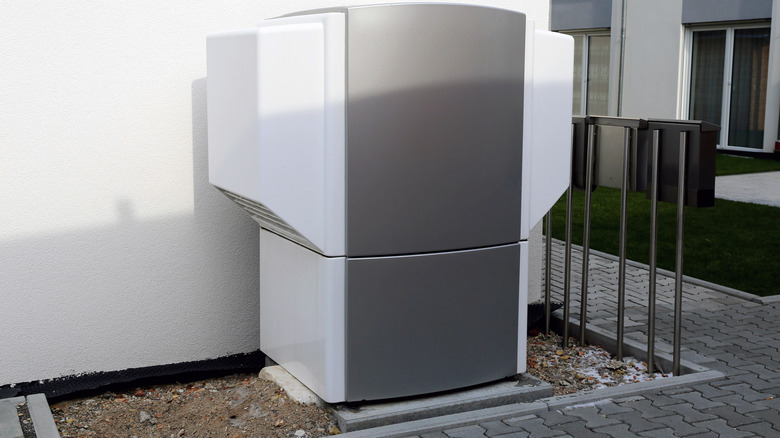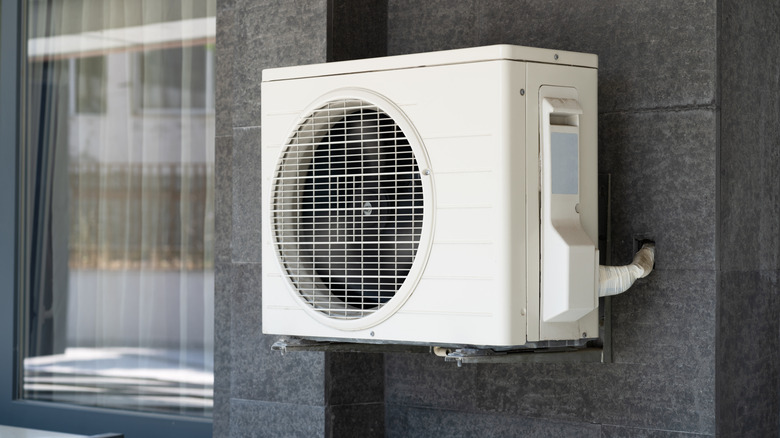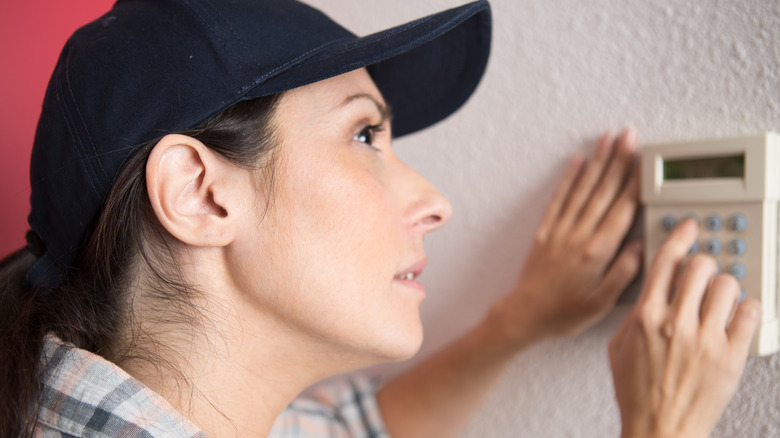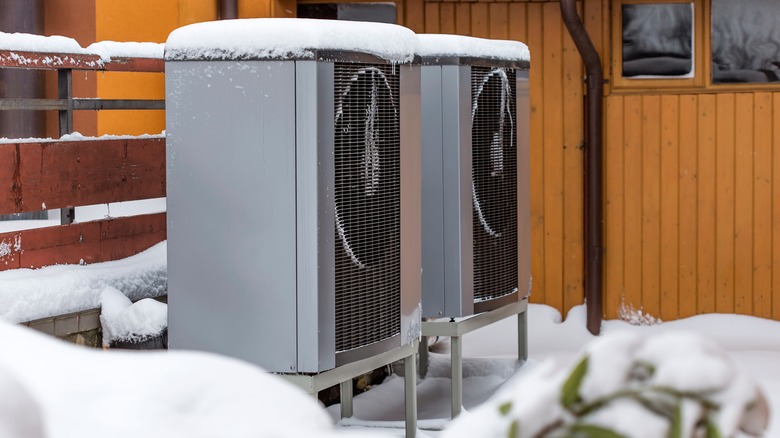Here's How A Heat Pump Works
You wouldn't guess that a piece of 19th-century technology might just be the key to unlocking sustainable heating and cooling for people across the world, but it's true (via The Renewable Energy Hub UK). The heat pump as we know it was invented in 1852, with the first system developed and built between 1855 and 1857.
Then as today, heat pumps take the heat lingering in the air outside of a building and transform it to either cool or heat that building. Heat pumps work on the basic principles of physics: All matter has thermal (meaning heat) energy (via Science Learning Hub). When matter is heated, the particles inside it get excited and begin moving more and faster. That's why hotter objects have more particles bouncing around in them than cooler ones do. Heat pumps harness this fact to transfer those bouncing, warmer particles to cooler areas, cooling or warming the indoor air in the process.
Of all the HVAC options available for consumers today, heat pumps are hailed as some of the most economical — not to mention efficient — heating and cooling systems available. Because they run on electricity, 22% of which is generated by sustainable alternatives like solar and wind, they can reduce your greenhouse gas emissions and save your hard-earned money, according to The Hill.
There are two types of heat pumps
In general, two kinds of heat pumps exist, and the one in your home or office is likely an air-source heat pump (via Carrier). These popular models move the heat from inside to outside or vice-versa, depending on the setting. Using electricity to transfer heat mechanically is a relatively recent development, but humans have warmed themselves with geothermal heat for millennia (via Renewable Energy Hub UK). In addition, people in Europe and China have harnessed the heat in their native hot springs to warm their indoor spaces for hundreds of years.
Geothermal heat pumps, also known as ground-source heat pumps, are the modern-day incarnation of this ancient technology. Ground-source pumps generally cost more to install due to the extensive digging that must be done in order to place the coils underground, Renewable Energy Hub UK explains. But, because the temperature of the ground remains stable year-round, geothermal heat pumps have greater efficiency because they use less electricity to operate than air-source heat pumps.
Additional technologies include hybrid heat pumps, absorption heat pumps, and ductless mini-split heat pumps, all of which operate on similar principles but differ in scale and heating source.
A heat pump can work as an air conditioner
In cooling mode, a heat pump works exactly like a traditional air conditioner, lowering the ambient temperature by extracting the heat from the air inside your house and pushing it outside (via Carrier). Since heat always moves toward cooler areas, heat pumps connect heat to a cooler material — a liquid refrigerant — that can be pressurized and de-pressurized to easily move the heat from inside to outside, per Energy Star.
Indoor air travels over the indoor heat pump coil containing the liquid refrigerant. The heat naturally transfers from the air to the refrigerant, and the now-cool air is blown back inside. The refrigerant, warmed from the heat of the indoor air, is pumped into an expansion valve, which acts as an evaporator. That increase in heat and pressure transform the refrigerant into a gas that is then pushed through a compressor, adding even more pressure and heat. Then the gas is then pushed through to the outdoor heat pump coil.
Because the heat inside the pressurized gas refrigerant is cooler than the air outside, the heat is absorbed from the atmosphere by the refrigerant. The pressure of the refrigerant is then raised in order to push the hot air outdoors, before recondensing into a cooler liquid, allowing colder air to be pumped into the house. The cycle continues in this way.
A heat pump can also act as a heater
No matter how cold it is outside, there is always some heat in the air warmer than the liquid refrigerant inside the heat pump (via Energy Star). To warm a given area, a heat pump reverses the process to add heat to indoor air instead of removing it, Carrier explains. To do this, the refrigerant is simply pumped through both coils but in the opposite direction. During its journey, the heat extracted from the outside is transferred to the refrigerant and blown inside your home by a fan on the inside portion of the heat pump.
Even in comparison to other forms of electric heating like baseboard heat or electric resistance furnaces, heat pumps use about half the amount of electricity to run, according to the U.S. Department of Energy. That's because heat pumps don't have to use energy and resources to generate heat like traditional furnaces — they simply and efficiently transfer it from one environment to another.
Heat pumps work in all kinds of climates
Because heat pumps are more popular in warmer regions, there is a pervasive myth that they don't work in climates that plunge below 32 degrees Fahrenheit during the winter months (via Carrier and Efficiency First California). When coupled with an energy-efficient furnace, the heat pump becomes a dual fuel system that only kicks in on the coldest of cold days, meaning that heat pumps make a great choice for your HVAC needs no matter where you live.
Heat pumps also pair well with photovoltaics, commonly known as solar panels. These connected devices allow the heat of the sun to power the regulation of indoor air temperature and even heat the water for kitchens, bathrooms, and pools. According to the nonprofit Efficiency First California, experts believe that heat pumps run by solar panels, along with batteries to store energy at home, are the future zero-emission standard for home energy. In this way, the heat pump in your home could play a crucial role in fighting the climate crisis.




